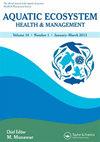Eutrophication in three Canadian Areas of Concern: Phytoplankton and major nutrient interactions
IF 0.8
4区 环境科学与生态学
Q4 ENVIRONMENTAL SCIENCES
引用次数: 17
Abstract
The Bay of Quinte, Hamilton Harbour and Toronto Harbour are all coastal regions of Lake Ontario that have experienced eutrophication and all have been designated as ‘Areas of Concern’ under the terms of the Great Lakes Water Quality Agreement. An assessment of the phytoplankton communities in relation to nutrient (P,N,Si) regimes was undertaken during 2015 (Bay of Quinte) and 2016 (Hamilton Harbour and Toronto Harbour) in order to compare and contrast the dynamics of eutrophication in the three ecosystems. Bay of Quinte was found to be phosphorus and silica enriched, but nitrogen limited which resulted in a phytoplankton community dominated by both filamentous diatoms and diazotrophic (N–fixing) cyanobacteria. Hamiton Harbour was phosphorus and nitrogen enriched, but silica depleted with a community dominated by small and large phytoflagellates in addition to experiencing cyanobacteria blooms. Toronto Harbour, by contrast, showed only moderate phosphorus enrichment and no nitrogen limitation, but some silica depletion; phytoplankton was dominated by smaller flagellates and pennate diatoms. Our findings suggest that while phosphorus was a key factor causing cultural eutrophication, other nutrients including nitrogen and silica also had important roles in determining the biomass and composition of the algal standing crop. Future management activities need to consider how the interactions of phosphorus with other nutrients (nitrogen, silica) affect the dynamics of the phytoplankton community in order to promote the recovery of eutrophic ecosystems.加拿大三个关注地区的富营养化:浮游植物和主要营养物质相互作用
昆特湾、汉密尔顿港和多伦多港都是安大略湖的沿海地区,都经历了富营养化,根据《五大湖水质协议》的条款,都被指定为“关注地区”。2015年(昆特湾)和2016年(汉密尔顿港和多伦多港)对浮游植物群落与营养(P、N、Si)状况的关系进行了评估,以比较和对比三个生态系统中的富营养化动态。昆特湾富含磷和二氧化硅,但氮含量有限,这导致浮游植物群落由丝状硅藻和重氮营养(固氮)蓝藻主导。哈密顿港富含磷和氮,但二氧化硅含量较低,除蓝藻大量繁殖外,群落以小型和大型植物鞭毛虫为主。相比之下,多伦多港仅表现出适度的磷富集,没有氮限制,但二氧化硅有所减少;浮游植物以较小的鞭毛虫和三角藻硅藻为主。我们的研究结果表明,虽然磷是导致养殖富营养化的关键因素,但包括氮和二氧化硅在内的其他营养物质在决定藻类生长作物的生物量和组成方面也发挥着重要作用。未来的管理活动需要考虑磷与其他营养物质(氮、二氧化硅)的相互作用如何影响浮游植物群落的动态,以促进富营养化生态系统的恢复。
本文章由计算机程序翻译,如有差异,请以英文原文为准。
求助全文
约1分钟内获得全文
求助全文
来源期刊

Aquatic Ecosystem Health & Management
环境科学-海洋与淡水生物学
CiteScore
1.70
自引率
0.00%
发文量
1
审稿时长
18-36 weeks
期刊介绍:
The journal publishes articles on the following themes and topics:
• Original articles focusing on ecosystem-based sciences, ecosystem health and management of marine and aquatic ecosystems
• Reviews, invited perspectives and keynote contributions from conferences
• Special issues on important emerging topics, themes, and ecosystems (climate change, invasive species, HABs, risk assessment, models)
 求助内容:
求助内容: 应助结果提醒方式:
应助结果提醒方式:


